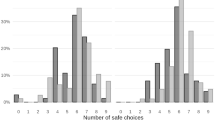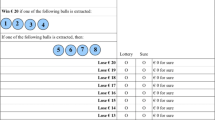Abstract
In this paper, we examine gender-specific reference-dependent preferences in a trust game experiment. Different amounts of show-up fee and one question eliciting subjects’ reference points were used to categorize subjects into three frames—the gain frame, the gain or loss frame, and the loss frame. We mainly found that (i) male subjects are risk-seeking in both the gain frame and the loss frame; (ii) women are not always more risk-averse than men; and (iii) women display other-regarding preferences only when they are in a gain frame. These results demonstrate the importance of taking gender difference and the reference-dependent preference into account together when examining individuals’ economic behaviors.



Similar content being viewed by others
Notes
The pairwise two-tailed proportion test indicates that there are no significant differences in the ratio of male to female across treatments (all p values > 0.10).
Only the experimental instructions of the session that offers subjects 500 JPY show-up fee are provided in Appendix A. Those of other sessions are very similar to the provided ones and available upon request.
In the treatments of 500 JPY and 1000 JPY show-up fee, both trusters and trustees received one additional envelope containing the show-up fee of 500 JPY and 1000 JPY, respectively.
In seven sessions, poker chips were used instead of cash. In these sessions, earned chips were exchanged to real money at the end of the experiment. The reason for us using poker chips is trying to investigate whether there is a tangibility effect of cash (Reinstein and Riener 2012; Shen and Takahashi 2013; Wang and Qin 2015) in our experiment. However, due to the fact that we statistically did not find any differences in either trusters’ or trustees’ behaviors between poker chip sessions and cash sessions, therefore, we pooled these data in our empirical analysis.
The truster’s payoff was calculated as the sum of “600 JPY − his/her transfer + the amount given back by the trustee + his/her show-up fee (0 or 500 JPY or 1000 JPY”, and the trustee’s payoff was calculated as the sum of “600 JPY + the tripled amount of the truster’s transfer − the amount that he/she gave back + his/her show-up fee (0 or 500 JPY or 1000 JPY)”.
An anonymous reviewer doubts whether the subjects seriously thought and declared their reference points, and suggests us to investigate the closeness of the subjects’ expected values and their real rewards. In total, the subjects’ expected value, on average, was 1299.64 JPY, while the average of their real rewards was 1394.29 JPY. With respect to males and females, the average of male subjects’ expected values was 1383.67 JPY, and they owned 1470.05 JPY on average. Female subjects expected to own 1223.98 JPY averagely, while they really owned 1326.06 JPY on average. These results exhibit that although the subjects’ expected values are lower than their real rewards in any cases, the differences (about 6–8%) are small enough to constitute an indirect evidence that the subjects seriously considered and declared their reference points.
Results on the three treatments with different amounts of show-up fee are provided in Appendix B.
When using porker chips, we also provided the information that explained porker chips were used and the number on the chips meant the yen amount and would be exchanged to cash after the experiment.
“500 JPY” was replaced with “a 500 JPY worth of poker chip” in Chip sessions. The following descriptions of the amount of money were replaced in the same way.
References
Abeler J, Falk A, Goette L, Huffman D (2011) Reference point and effort provision. Am Econ Rev 101:470–492
Andersen S, Brandon A, Gneezy U, List JA (2014) Toward an understanding of reference-dependent labor supply: theory and evidence from a field experiment. NBER Working Paper Series No. 20695
Bellemare C, Kröger S (2007) On representative trust. Eur Econ Rev 51(1):183–202
Berg J, Dickhaut J, McCabe K (1995) Trust, reciprocity and social history. Games Econ Behav 10:122–142
Bohnet I (2007) Why women and men trust others? In: Frey Bruno S, Stutzer Alois (eds) Economics and psychology: a promising new cross-disciplinary field. MIT Press, Cambridge, London, pp 89–110
Bohnet I, Herrmann B, Zeckhauser R (2010) Trust and the reference points for trustworthiness in gulf and western countries. Q J Econ 125(2):811–828
Buchan NR, Croson R, Solnich SJ (2008) Trust and gender: an examination of behavior and beliefs in the investment game. J Econ Behav Organ 68(3–4):466–476
Charness G, Gneezy U (2012) Strong evidence for gender differences in risk taking. J Econ Behav Organ 83(1):50–58
Chaudhuri A, Gangadharan L (2007) An experimental analysis of trust and trustworthiness. South Econ J 73(4):959–985
Cox JC, Deck CA (2006) When are women more generous than men? Econ Inq 44(4):587–598
Croson R, Buchan NR (1999) Gender and culture: international experimental evidence from trust games. Am Econ Rev 89(2):386–391
Croson R, Gneezy U (2009) Gender differences in preferences. J Econ Lit 47(2):1–27
Fehr E, Hart O, Zehnder C (2011) Contracts as reference points—experimental evidence. Am Econ Rev 101:493–525
Garbarino E, Slonim R (2009) The robustness of trust and reciprocity across a heterogeneous US population. J Econ Behav Organ 69(3):226–240
Hilken K, Rosenkranz S, Jaegher K, Jeders M (2013) Reference points, performance and ability: a real effort experiment on framed incentive schemes. Discussion Paper Series 13–15, Utrecht School of Economics, Tjalling C. Koopmans Research Institute
Innocenti A, Pazienza MG (2006) Altruism and gender in the trust game. University of Sienna Department of Economics Working Paper 5/2006
Kahneman D, Tversky A (1979) Prospect theory: an analysis of decision under risk. Econometrica 47(2):263–292
Reinstein D, Riener G (2012) Decomposing desert and tangibility effects in a charitable giving experiment. Exp Econ 15:229–240
Schwieren C, Sutter M (2008) Trust in cooperation or ability? An experimental study on gender differences. Econ Lett 99(3):494–497
Shen J, Takahashi H (2013) A cash effect in ultimatum game experiments. J Socio-Econ 47:94–102
Snilders C, Keren G (2001) Do you trust? Whom do you trust? When do you trust? Adv Group Process 18:129–160
Tversky A, Kahneman D (1991) Loss aversion in riskless choice: a reference-dependent model. Q J Econ 106:1039–1061
Wang S, Qin X (2015) The effect of digitalization on penalty payments: an experimental investigation. J Neurosci Psychol Econ 8(4):250–261
Acknowledgements
Financial support from the Japanese Ministry of Education, Culture, Sports, Science and Technology through Grants-in-aid for Scientific Research (C) 25380234 and 15K03353 is gratefully acknowledged. All of the views expressed in this paper and any errors are the sole responsibility of the authors.
Author information
Authors and Affiliations
Corresponding author
Additional information
Publisher's Note
Springer Nature remains neutral with regard to jurisdictional claims in published maps and institutional affiliations.
Appendices
Appendix A: Experimental instructions (originally written in Japanese)
1.1 A.1 For trusters in the session with 500 JPY show-up fee
Procedure of the experiment
We will now explain the procedure of the experiment. Please read carefully and make sure you understand.
In another room (lecture room A304), there are people who will be paired with you. You will never be informed of the identity of these counterparts.
This experiment will be done only once.Footnote 8
-
1.
At the beginning of the experiment, both you and your counterpart receive 500 JPYFootnote 9 show-up fee in an envelope. Note that this money is independent of your performance in the experiment.
-
2.
Then, you receive another envelope (hereinafter referred to as Envelope A) containing 600 JPY and an empty envelope (hereinafter referred to as Envelope B) on which a sequence of characters is printed.
-
3.
You must decide how much you are going to transfer to your counterpart. Please decide the amount from 0 JPY to 600 JPY in units of 10 JPY.
-
4.
After you make your decision, please write the amount in the field “Your transfer” of the record sheet. Then put the money being transferred in Envelope B and put the remainder in Envelope A.
-
5.
The experimenter will collect Envelope B, make your transferred amount tripled and bring Envelope B containing the tripled amount of money to your counterpart.
-
6.
Note your counterpart also receives 600 JPY as you do. Your counterpart will decide how much to give back to you from the sum of the tripled amount and his/her 600 JPY.
-
7.
Then, the experimenter will bring Envelope B containing the money that your counterpart gives back to you. Please check the amount and write it in the field “Amount given back by the counterpart” of the record sheet.
-
8.
Please calculate your total payoff which is the sum of “600 JPY − your transfer + the amount given back by your counterpart + 500 JPY show-up fee” and write the amount in the field of “Your payoff” of the record sheet.
-
9.
Finally, check whether the above amount is consistent with the cash you hold. Please take the money and leave the room quietly if it is consistent.
1.2 A.2. For trustees in the session with 500 JPY show-up fee
Procedure of the experiment
We will now explain the procedure of the experiment. Please read carefully and make sure you understand.
In another room (lecture room A303), there are people who will be paired with you. You will never be informed of the identity of these counterparts.
This experiment will be done only once.
-
1.
At the beginning of the experiment, both you and your counterpart receive 500 JPY show-up fee in an envelope. Note that this money is independent of your performance in the experiment.
-
2.
Then, you receive another envelope (hereinafter referred to as Envelope A) containing 600 JPY.
-
3.
Your counterpart also receives 600 JPY and decides how much to transfer to you from the 600 JPY.
-
4.
The experimenter will triple the transferred amount and put them into an envelope (hereinafter referred to as Envelope B) on which “○○○ × 3=###” is written. ○○○ is the transferred amount and ### is the tripled amount. Then please confirm the transferred and tripled amounts and write them in the fields “The transferred amount” and “The tripled amount” of the record sheet, respectively.
-
5.
You are to decide how much to give back to your counterpart. After deciding the amount, please write it in the field “Amount giving back” of the record sheet. Then put the money being given back in Envelope B and put the remainder in Envelope A.
-
6.
The experimenter will collect Envelope B and bring it to your counterpart.
-
7.
Please calculate your total payoff which is the sum of “600 JPY + the tripled amount − the amount that you give back to your counterpart + 500 JPY show-up fee” and write the amount in the field of “Your payoff” of the record sheet.
-
8.
Finally, check whether the above amount is consistent with the cash you hold. Please take the money and leave the room quietly if it is consistent.
Appendix B
See Table 5.
About this article
Cite this article
Takahashi, H., Shen, J. & Ogawa, K. Gender-specific reference-dependent preferences in the experimental trust game. Evolut Inst Econ Rev 17, 25–38 (2020). https://doi.org/10.1007/s40844-019-00155-z
Published:
Issue Date:
DOI: https://doi.org/10.1007/s40844-019-00155-z




